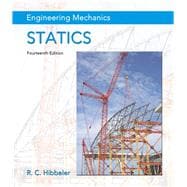Packageconsistsof:
MasteringEngineering should only be purchased when required by an instructor.
- 0133915425 / 9780133915426 Engineering Mechanics: Statics
- 0133916375 / 9780133916379 MasteringEngineering with Pearson eText -- Standalone Access Card -- for Engineering Mechanics: Statics & Dynamics
A Proven Approach to Conceptual Understanding and Problem-solving Skills
Engineering Mechanics: Statics excels in providing a clear and thorough presentation of the theory and application of engineering mechanics. Engineering Mechanics empowers students to succeed by drawing upon Professor Hibbeler’s everyday classroom experience and his knowledge of how students learn. This text is shaped by the comments and suggestions of hundreds of reviewers in the teaching profession, as well as many of the author’s students.
The Fourteenth Edition includes new Preliminary Problems, which are intended to help students develop conceptual understanding and build problem-solving skills. The text features a large variety of problems from a broad range of engineering disciplines, stressing practical, realistic situations encountered in professional practice, and having varying levels of difficulty.
Also Available with MasteringEngineering -- an online homework, tutorial, and assessment program designed to work with this text to engage students and improve results. Interactive, self-paced tutorials provide individualized coaching to help students stay on track. With a wide range of activities available, students can actively learn, understand, and retain even the most difficult concepts. The text and MasteringEngineering work together to guide students through engineering concepts with a multi-step approach to problems.

